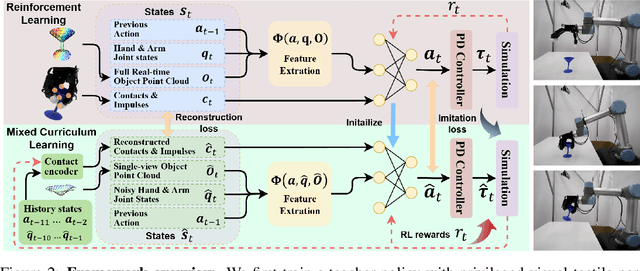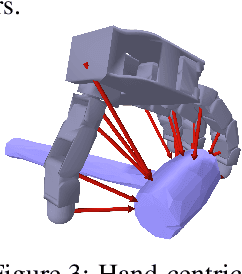Zijian Wu
HLSMAC: A New StarCraft Multi-Agent Challenge for High-Level Strategic Decision-Making
Sep 16, 2025Abstract:Benchmarks are crucial for assessing multi-agent reinforcement learning (MARL) algorithms. While StarCraft II-related environments have driven significant advances in MARL, existing benchmarks like SMAC focus primarily on micromanagement, limiting comprehensive evaluation of high-level strategic intelligence. To address this, we introduce HLSMAC, a new cooperative MARL benchmark with 12 carefully designed StarCraft II scenarios based on classical stratagems from the Thirty-Six Stratagems. Each scenario corresponds to a specific stratagem and is designed to challenge agents with diverse strategic elements, including tactical maneuvering, timing coordination, and deception, thereby opening up avenues for evaluating high-level strategic decision-making capabilities. We also propose novel metrics across multiple dimensions beyond conventional win rate, such as ability utilization and advancement efficiency, to assess agents' overall performance within the HLSMAC environment. We integrate state-of-the-art MARL algorithms and LLM-based agents with our benchmark and conduct comprehensive experiments. The results demonstrate that HLSMAC serves as a robust testbed for advancing multi-agent strategic decision-making.
Breast Ultrasound Tumor Generation via Mask Generator and Text-Guided Network:A Clinically Controllable Framework with Downstream Evaluation
Jul 10, 2025Abstract:The development of robust deep learning models for breast ultrasound (BUS) image analysis is significantly constrained by the scarcity of expert-annotated data. To address this limitation, we propose a clinically controllable generative framework for synthesizing BUS images. This framework integrates clinical descriptions with structural masks to generate tumors, enabling fine-grained control over tumor characteristics such as morphology, echogencity, and shape. Furthermore, we design a semantic-curvature mask generator, which synthesizes structurally diverse tumor masks guided by clinical priors. During inference, synthetic tumor masks serve as input to the generative framework, producing highly personalized synthetic BUS images with tumors that reflect real-world morphological diversity. Quantitative evaluations on six public BUS datasets demonstrate the significant clinical utility of our synthetic images, showing their effectiveness in enhancing downstream breast cancer diagnosis tasks. Furthermore, visual Turing tests conducted by experienced sonographers confirm the realism of the generated images, indicating the framework's potential to support broader clinical applications.
On Reasoning Strength Planning in Large Reasoning Models
Jun 10, 2025Abstract:Recent studies empirically reveal that large reasoning models (LRMs) can automatically allocate more reasoning strengths (i.e., the number of reasoning tokens) for harder problems, exhibiting difficulty-awareness for better task performance. While this automatic reasoning strength allocation phenomenon has been widely observed, its underlying mechanism remains largely unexplored. To this end, we provide explanations for this phenomenon from the perspective of model activations. We find evidence that LRMs pre-plan the reasoning strengths in their activations even before generation, with this reasoning strength causally controlled by the magnitude of a pre-allocated directional vector. Specifically, we show that the number of reasoning tokens is predictable solely based on the question activations using linear probes, indicating that LRMs estimate the required reasoning strength in advance. We then uncover that LRMs encode this reasoning strength through a pre-allocated directional vector embedded in the activations of the model, where the vector's magnitude modulates the reasoning strength. Subtracting this vector can lead to reduced reasoning token number and performance, while adding this vector can lead to increased reasoning token number and even improved performance. We further reveal that this direction vector consistently yields positive reasoning length prediction, and it modifies the logits of end-of-reasoning token </think> to affect the reasoning length. Finally, we demonstrate two potential applications of our findings: overthinking behavior detection and enabling efficient reasoning on simple problems. Our work provides new insights into the internal mechanisms of reasoning in LRMs and offers practical tools for controlling their reasoning behaviors. Our code is available at https://github.com/AlphaLab-USTC/LRM-plans-CoT.
ChartGalaxy: A Dataset for Infographic Chart Understanding and Generation
May 24, 2025Abstract:Infographic charts are a powerful medium for communicating abstract data by combining visual elements (e.g., charts, images) with textual information. However, their visual and structural richness poses challenges for large vision-language models (LVLMs), which are typically trained on plain charts. To bridge this gap, we introduce ChartGalaxy, a million-scale dataset designed to advance the understanding and generation of infographic charts. The dataset is constructed through an inductive process that identifies 75 chart types, 330 chart variations, and 68 layout templates from real infographic charts and uses them to create synthetic ones programmatically. We showcase the utility of this dataset through: 1) improving infographic chart understanding via fine-tuning, 2) benchmarking code generation for infographic charts, and 3) enabling example-based infographic chart generation. By capturing the visual and structural complexity of real design, ChartGalaxy provides a useful resource for enhancing multimodal reasoning and generation in LVLMs.
Oral Imaging for Malocclusion Issues Assessments: OMNI Dataset, Deep Learning Baselines and Benchmarking
May 21, 2025Abstract:Malocclusion is a major challenge in orthodontics, and its complex presentation and diverse clinical manifestations make accurate localization and diagnosis particularly important. Currently, one of the major shortcomings facing the field of dental image analysis is the lack of large-scale, accurately labeled datasets dedicated to malocclusion issues, which limits the development of automated diagnostics in the field of dentistry and leads to a lack of diagnostic accuracy and efficiency in clinical practice. Therefore, in this study, we propose the Oral and Maxillofacial Natural Images (OMNI) dataset, a novel and comprehensive dental image dataset aimed at advancing the study of analyzing dental images for issues of malocclusion. Specifically, the dataset contains 4166 multi-view images with 384 participants in data collection and annotated by professional dentists. In addition, we performed a comprehensive validation of the created OMNI dataset, including three CNN-based methods, two Transformer-based methods, and one GNN-based method, and conducted automated diagnostic experiments for malocclusion issues. The experimental results show that the OMNI dataset can facilitate the automated diagnosis research of malocclusion issues and provide a new benchmark for the research in this field. Our OMNI dataset and baseline code are publicly available at https://github.com/RoundFaceJ/OMNI.
CKMDiff: A Generative Diffusion Model for CKM Construction via Inverse Problems with Learned Priors
Apr 24, 2025Abstract:Channel knowledge map (CKM) is a promising technology to enable environment-aware wireless communications and sensing with greatly enhanced performance, by offering location-specific channel prior information for future wireless networks. One fundamental problem for CKM-enabled wireless systems lies in how to construct high-quality and complete CKM for all locations of interest, based on only limited and noisy on-site channel knowledge data. This problem resembles the long-standing ill-posed inverse problem, which tries to infer from a set of limited and noisy observations the cause factors that produced them. By utilizing the recent advances of solving inverse problems with learned priors using generative artificial intelligence (AI), we propose CKMDiff, a conditional diffusion model that can be applied to perform various tasks for CKM constructions such as denoising, inpainting, and super-resolution, without having to know the physical environment maps or transceiver locations. Furthermore, we propose an environment-aware data augmentation mechanism to enhance the model's ability to learn implicit relations between electromagnetic propagation patterns and spatial-geometric features. Extensive numerical results are provided based on the CKMImageNet and RadioMapSeer datasets, which demonstrate that the proposed CKMDiff achieves state-of-the-art performance, outperforming various benchmark methods.
NoisyRollout: Reinforcing Visual Reasoning with Data Augmentation
Apr 17, 2025Abstract:Recent advances in reinforcement learning (RL) have strengthened the reasoning capabilities of vision-language models (VLMs). However, enhancing policy exploration to more effectively scale test-time compute remains underexplored in VLMs. In addition, VLMs continue to struggle with imperfect visual perception, which in turn affects the subsequent reasoning process. To this end, we propose NoisyRollout, a simple yet effective RL approach that mixes trajectories from both clean and moderately distorted images to introduce targeted diversity in visual perception and the resulting reasoning patterns. Without additional training cost, NoisyRollout enhances the exploration capabilities of VLMs by incorporating a vision-oriented inductive bias. Furthermore, NoisyRollout employs a noise annealing schedule that gradually reduces distortion strength over training, ensuring benefit from noisy signals early while maintaining training stability and scalability in later stages. With just 2.1K training samples, NoisyRollout achieves state-of-the-art performance among open-source RL-tuned models on 5 out-of-domain benchmarks spanning both reasoning and perception tasks, while preserving comparable or even better in-domain performance.
CKMImageNet: A Dataset for AI-Based Channel Knowledge Map Towards Environment-Aware Communication and Sensing
Apr 14, 2025Abstract:With the increasing demand for real-time channel state information (CSI) in sixth-generation (6G) mobile communication networks, channel knowledge map (CKM) emerges as a promising technique, offering a site-specific database that enables environment-awareness and significantly enhances communication and sensing performance by leveraging a priori wireless channel knowledge. However, efficient construction and utilization of CKMs require high-quality, massive, and location-specific channel knowledge data that accurately reflects the real-world environments. Inspired by the great success of ImageNet dataset in advancing computer vision and image understanding in artificial intelligence (AI) community, we introduce CKMImageNet, a dataset developed to bridge AI and environment-aware wireless communications and sensing by integrating location-specific channel knowledge data, high-fidelity environmental maps, and their visual representations. CKMImageNet supports a wide range of AI-driven approaches for CKM construction with spatially consistent and location-specific channel knowledge data, including both supervised and unsupervised, as well as discriminative and generative AI methods.
ToolTipNet: A Segmentation-Driven Deep Learning Baseline for Surgical Instrument Tip Detection
Apr 13, 2025Abstract:In robot-assisted laparoscopic radical prostatectomy (RALP), the location of the instrument tip is important to register the ultrasound frame with the laparoscopic camera frame. A long-standing limitation is that the instrument tip position obtained from the da Vinci API is inaccurate and requires hand-eye calibration. Thus, directly computing the position of the tool tip in the camera frame using the vision-based method becomes an attractive solution. Besides, surgical instrument tip detection is the key component of other tasks, like surgical skill assessment and surgery automation. However, this task is challenging due to the small size of the tool tip and the articulation of the surgical instrument. Surgical instrument segmentation becomes relatively easy due to the emergence of the Segmentation Foundation Model, i.e., Segment Anything. Based on this advancement, we explore the deep learning-based surgical instrument tip detection approach that takes the part-level instrument segmentation mask as input. Comparison experiments with a hand-crafted image-processing approach demonstrate the superiority of the proposed method on simulated and real datasets.
RobustDexGrasp: Robust Dexterous Grasping of General Objects from Single-view Perception
Apr 07, 2025



Abstract:Robust grasping of various objects from single-view perception is fundamental for dexterous robots. Previous works often rely on fully observable objects, expert demonstrations, or static grasping poses, which restrict their generalization ability and adaptability to external disturbances. In this paper, we present a reinforcement-learning-based framework that enables zero-shot dynamic dexterous grasping of a wide range of unseen objects from single-view perception, while performing adaptive motions to external disturbances. We utilize a hand-centric object representation for shape feature extraction that emphasizes interaction-relevant local shapes, enhancing robustness to shape variance and uncertainty. To enable effective hand adaptation to disturbances with limited observations, we propose a mixed curriculum learning strategy, which first utilizes imitation learning to distill a policy trained with privileged real-time visual-tactile feedback, and gradually transfers to reinforcement learning to learn adaptive motions under disturbances caused by observation noises and dynamic randomization. Our experiments demonstrate strong generalization in grasping unseen objects with random poses, achieving success rates of 97.0% across 247,786 simulated objects and 94.6% across 512 real objects. We also demonstrate the robustness of our method to various disturbances, including unobserved object movement and external forces, through both quantitative and qualitative evaluations. Project Page: https://zdchan.github.io/Robust_DexGrasp/
 Add to Chrome
Add to Chrome Add to Firefox
Add to Firefox Add to Edge
Add to Edge